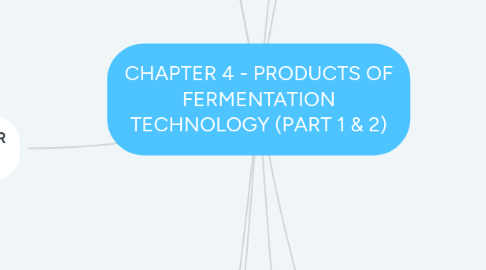
1. OVERPRODUCTION OF METABOLITES
1.1. Important as to
1.1.1. To shorten the production time and space
1.1.2. Reducing the product cost
2. APPROACHES TO INCREASE METABOLITE PRODUCTION
2.1. Optimization of cultural conditions (pH, types of microorganisms, aeration etc.)
2.2. Genetic approaches for overproduction of metabolites (mutation, recombinant DNA technology)
3. FERMENTATION PRODUCTS FOR AGRICULTURE SECTOR
3.1. 1. Silage
3.1.1. Silage fermentation is a technique used to preserve fresh forage crops (e.g; maize, grasses, legumes, wheat and lucerne)
3.1.1.1. STAGE IN PRODUCING SILAGE
3.1.1.1.1. 1. AEROBIC
3.1.1.1.2. 2. FERMENTATION
3.1.1.1.3. 3. STABLE
3.1.1.1.4. 4. FEED OUT/AEROBIC SPOILAGE
3.1.1.2. ADVANTAGES OF SILAGE FERMENTATION
3.1.1.2.1. 1. Healthy balance of digestive bacteria
3.1.1.2.2. 2. Inhibits mold and improves feeding value
3.1.1.2.3. 3. Provides organic benefits and growth stimulation
3.2. 2. Microbial Pesticides
3.2.1. Most widely used microbial pesticides are subspecies and strains of Bacillus thuringiensis, or Bt
3.2.2. Increase yield and prevent plant diseases
3.2.3. ADVANTAGES OF MICROBIAL PESTICIDES
3.2.3.1. 1. Less toxic than conventional pesticides
3.2.3.2. 2. Affect only the target pest and closely related organisms
3.2.3.3. 3. Users need to know a great deal about managing pests and must carefully follow all label directions.
3.3. 3. Single Cell Proteins (SCP)
3.3.1. Definition - protein derived from a culture of single-celled organisms, used especially as a food supplement
3.3.2. CHARACTERISTIC
3.3.2.1. 1. Produced all round the year
3.3.2.2. 2. High protein content
3.3.2.3. 3. Not require a large expanse of land
3.3.2.4. 4. Grown on waste
3.3.3. PRODUCTION OF SCP
3.3.3.1. 1.Submerged Fermentation
3.3.3.1.1. Substrate to be fermented is always in a liquid which contains the nutrient needed for growth
3.3.3.2. 2. Semisolid State Fermentation
3.3.3.2.1. In semisolid fermentation, the preparation of the substrate is not as cleared; it is also more used in solid state (eg. Cassava waste)
3.3.4. ADVANTAGES OF SINGLE CELL PROTEIN
3.3.4.1. 1. High protein and low fat content
3.3.4.2. 2. Good source of vitamins particularly B-complex
3.3.4.3. 3. Yeast single-cell proteins (SCPs) are playing a greater role in the evolution of aquaculture diets
4. FERMENTATION PRODUCTS FOR MEDICAL AND NUTRACEUTICAL USE
4.1. 1. MEDICAL USE
4.1.1. Antibiotics by fermentation
4.1.1.1. Use directly in human therapy
4.1.1.2. Make up the majority contribution of antibiotics agents in the treatment of human disease
4.1.2. Involved in the production of new therapeutics drugs
4.1.2.1. 1. Cancer therapy
4.1.2.2. 2. Treatment of infectious disease
4.1.2.3. 3. Antibody fragments
4.1.2.4. 4. Fibroblast growth factors
4.1.3. Also used for the commercial production of materials required for;-
4.1.3.1. Diagnostic kits
4.1.3.2. Drug delivery
4.1.3.3. Medical devices
4.2. 2. PHARMACEUTICAL USE
4.2.1. Molecules that are of primary interest to the pharmaceutical industry;-
4.2.1.1. 1. Small molecules
4.2.1.2. 2. Larger molecules
4.2.1.3. 3. Macromolecules
5. IMPACTS OF FT PRODUCTS TO COMMUNITIES
5.1. 1. Improving food security
5.2. 2. Increasing income and employment
5.3. 3. Improving nutrition
5.4. 4. Medicinal benefits
5.5. 5. Improving cultural and social will-being
6. MICROBIOLOGICAL PRODUCTS OF FERMENTATION
6.1. Cells
6.1.1. Yeast cells
6.2. Bioconversion
6.2.1. Product (for example, steriod bioconversions)
6.3. Products from cells
6.3.1. Enzymes (glucose isomerase)
6.3.2. Antibiotics (penicillin)
6.3.3. Alcohol (ethanol)
6.3.4. Chemicals (citric acid)
7. WHAT IS METABOLITE?
7.1. Metabolites are the intermediates and products of metabolism
7.2. Synthesize by microorganisms during their growth phase;-
7.2.1. PRIMARY METABOLITE - essential for normal growth, development and reproduction.
7.2.1.1. Small molecules of living cell
7.2.1.2. Often referred to as a central metabolite
7.2.1.3. Related to the synthesis of microbial cells in the growth phase
7.2.1.4. Include amino acids, alcohol, organic acids, vitamin
7.2.2. SECONDARY METABOLITE - not essential for growth and reproduction, diverse, often species-specific-end-products
7.2.2.1. Accumulate after the active growth of any particular microorganisms
7.2.2.2. Have no direct relationship with the synthesis of cell material and natural growth
7.2.2.3. Include antibiotics and toxins
8. FERMENTATION PRODUCTS FOR FOOD AND INDUSTRIAL USES
8.1. 1. Cheese
8.1.1. MILK - is a highly perishable food raw material
8.1.2. 1. Milk Treatment
8.1.3. 2. Starter Culture Addition
8.1.4. 3. Coagulation
8.1.5. 4. Cutting The Coagulation
8.1.6. 5. Heating or Cooking The Curds
8.1.7. 6. Whey Removal
8.1.8. 7. Milling The Curd
8.1.9. 8. Ripening
8.2. 2. Yogurt
8.2.1. Ethanol released gives the raw yogurt its characteristic flavour
8.2.2. The pH of yogurt is about 4.2- 4.4 - Prevent other harmful bacteria from colonizing the yogurt (a method of preservation)
8.2.3. Not only has the same nutritional value of milk, but that it is more easily digested
8.3. 3. Alcohol
8.3.1. Alcoholic Fermentation
8.3.2. Produce ethyl alcohol and carbon dioxide
8.3.3. Produces alcoholic beverages and causes bread dough to rise
8.4. 4. Food acids
8.4.1. Lactic Acids
8.4.1.1. Lactic acid fermentatin
8.4.1.2. Produces lactic acid
8.4.1.3. Occurs in most organisms, including humans
8.4.1.4. Used to produce beverages such as buttermilk and foods such as cheese, yogurt, and pickles
8.4.2. Citric Acids
8.4.2.1. A commercially valuable organic acid, widely used in food, pharmaceutical and beverage industries
8.4.2.2. The main additive used in the food industry
8.4.2.3. Widely used to impart a pleasant, tart flavor to foods and beverages
8.4.3. Compound added to make flavors "SHARPER"
8.4.4. Also act as preservatives and antioxidants
8.4.5. Include vinegar, citric acid, tartaric acid, malic acid fumaric acid, and lactic acid
9. IMPORTANCE AND BENEFITS OF FERMENTATION TECHNOLOGY
9.1. Importances of ft to industries
9.1.1. 1. Expanding the range of products that are derived from agricultural crops
9.1.2. 2. Improvement of welfare during winters or less productive seasons
9.1.3. 3. Overcome seasonality constraints
9.1.4. 4. Antiseptic and a solvent in medical field
9.1.5. 5. Water quality poor
9.1.6. Improvements on effluents and diseases control

